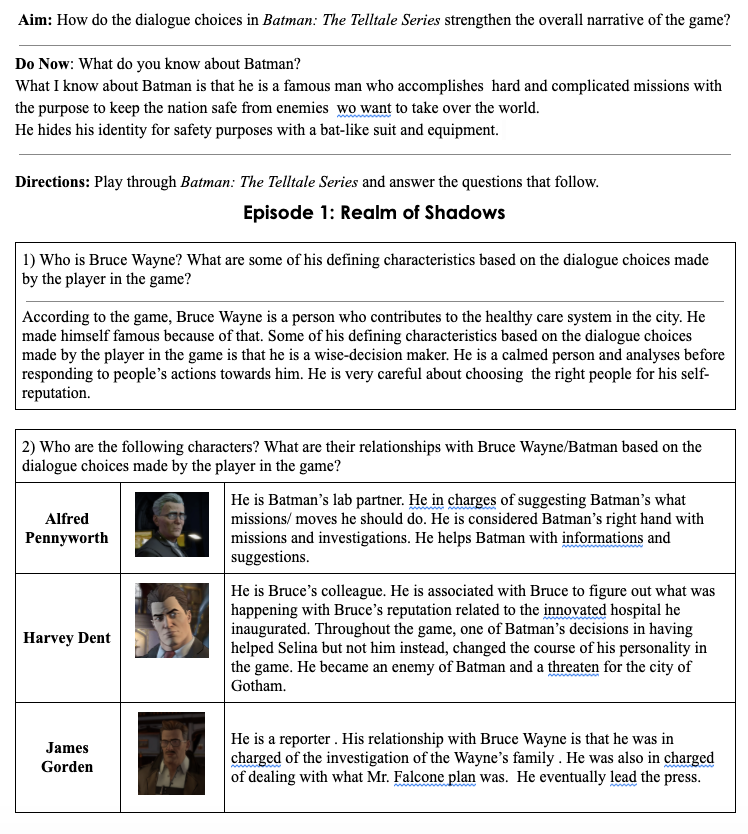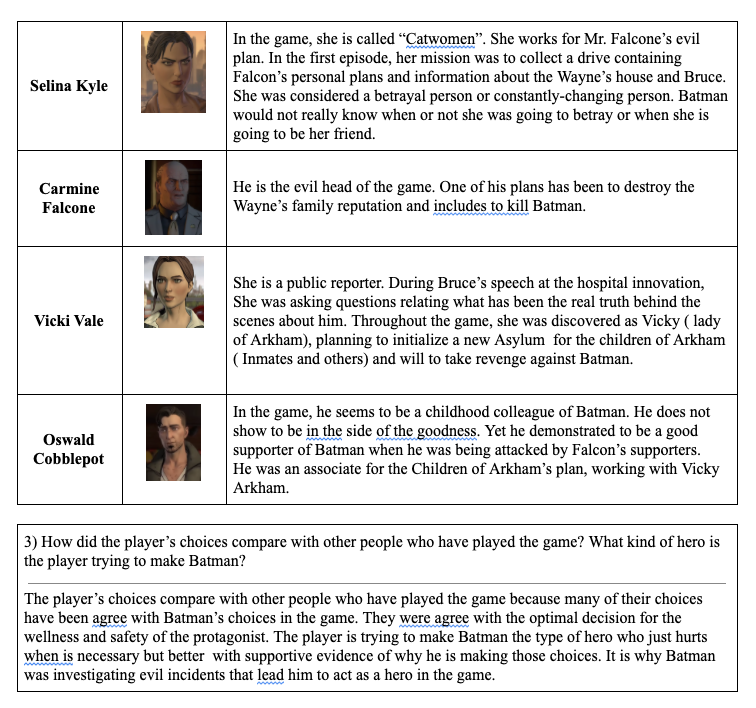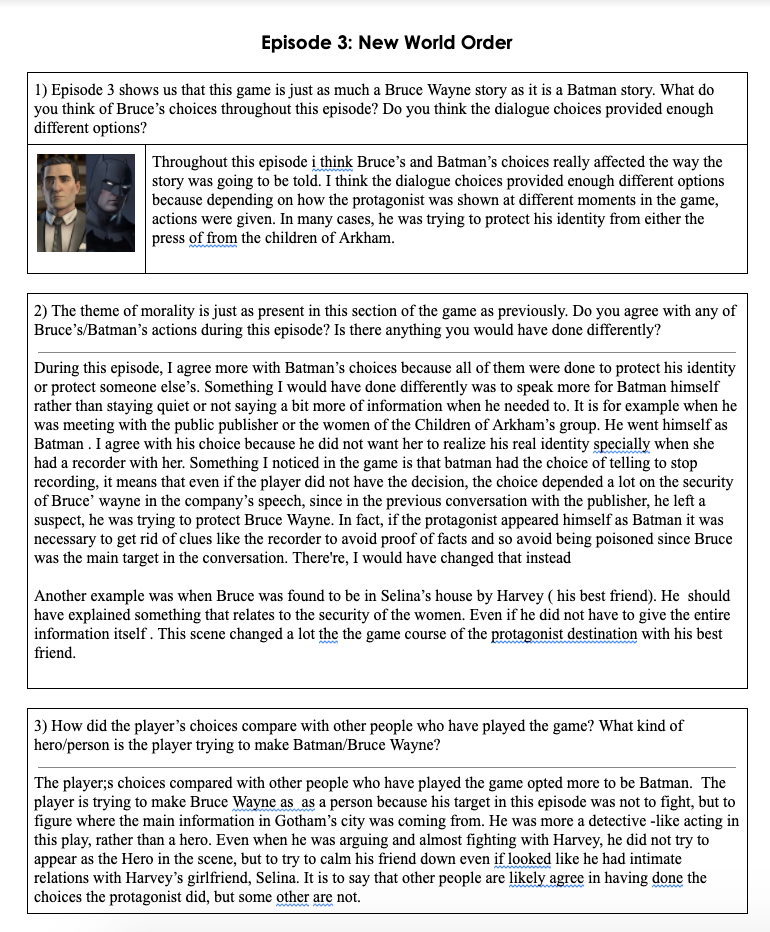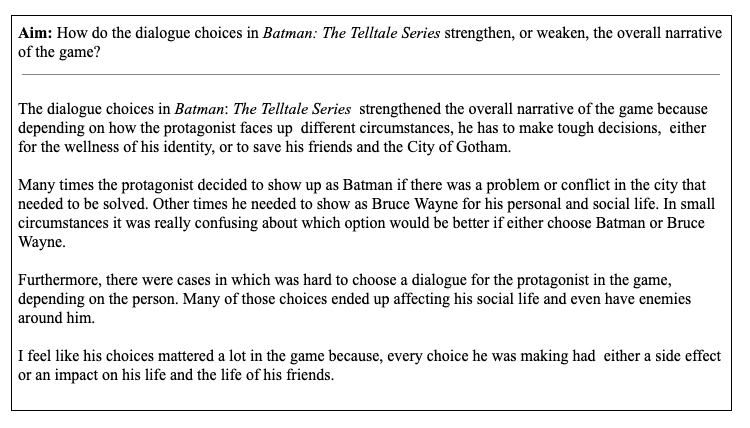I Taught With Batman: The Telltale Series
- Zack
- Jun 12, 2020
- 8 min read
Updated: Oct 26, 2020
What's going on everyone?
As many of you know, one of the courses I teach is a video game English Language Arts class. We play through video games and treat them as literature. Since it's an elective class, I was not originally planning on continuing it as we moved into remote learning. Remote learning and dealing with a pandemic is tough as it is and I didn't want to provide my students with more work than needed. A number of them however, told me that they wanted to continue playing together if possible and they especially wanted to play a superhero game. So I quickly put together a curriculum using Batman: The Telltale Series. You can find the lesson plan, handouts, and slides here.

I chose Batman: The Telltale Series because of its use of dialogue choices and branching narratives. Instead of focusing on fighting and action, the core gameplay in the games lies in the decisions the player makes as a Bruce Wayne/Batman. The player gets to choose the dialogue for the protagonist in every scene. These decisions even have consequences that shape the course of the story. Characters will remember and notice what you say, leading to potentially different outcomes. This allows the player to shape the protagonist how they see fit. My students wanted Bruce to a "proper gentleman." Through its use of dialogue choices, it allows our students to take an active role in crafting a story with one of the most popular characters ever made.
The Aim of the lesson was, "How do the dialogue choices in Batman: The Telltale Series strengthen or weaken the overall narrative of the game?" I wanted them to analyze the effectiveness of dialogue choices since they are are a narrative device unique to video games.

In order to play I had a student of mine stream the game online using a website called twitch. I bought him a copy of the game to play while the rest of the class watched online. Everyone was able to communicate with one another in the provided chat box. This allowed the students to continue conversing about the game even though we were no longer together in my classroom. The format generally worked well. The student who played used a to speak out loud and ask questions to the rest of the chat. He would often ask which dialogue choice or action they preferred. The only real issue is there is sometimes a lag when streaming online. Many of the choices in game also have a time limit so it was sometimes difficult for my student to engage with the chat before time was up.
The game is broken into five episodes. I am going to break down how each week went.
Episode 1: Realm of Shadows
I started the unit off by asking my students what they know about Batman. Yes he is a very popular character, but many of my students are not well versed in comics or video games. This student in particular only knew that he wants to protect the nation while using a bat suit to hide his identity. The first episode of the game provides us with the necessary introductions to all of the game's characters. So to start off I had my students take notes on each character; describing their personalities and relationships with Bruce/Batman. I also wanted them to start paying attention to how their chosen dialogue choices potentially affected these relationships. The final question that I asked at the end of each class was, "How did the player’s choices compare with other people who have played the game? What kind of hero is the player trying to make Batman?" I asked this because when you finish one episode, the game actually provides a summary of the most important decisions you had made and even compares them to other people who have played the game. This allows the students to see how other people may act differently when playing as either Bruce or Batman.

Episode 2: Children of Arkham
When I was originally planning this curriculum I thought the main focus would be on the use of dialogue choices. While that is still the main purpose of playing this game, I actually found the portrayal of Bruce Wayne/Batman to be really compelling. The plot in this game is not really the strongest- It's often very cheesy and over the top, but it does something that few Batman stories do. It gives Bruce Wayne the spotlight. The player probably spends more time in a business suit than dressed as the Dark Knight. There are even moments where the player can choose whether to visit someone as Bruce, or Batman. The student we had playing tended to favor playing as Batman which would take the story in a certain direction. If you read the student answer to the first question of this episode you'll notice that they would have actually preferred to complete a task as Bruce. This game also changes some of the original Batman lore. Bruce's parents are criminals in this game's canon. This forces the player to think about their choices in dialogue because Bruce needs to prove that he is not responsible for the sins of his parents. It was fun having my students discuss about whether or not someone can be at all responsible for their parents' failures and even debate about what Bruce should do with his fortune now that we know the Wayne fortune was built on lies.
Episode 3: New World Order
Telltale Games, the developer of Batman: The Telltale Series, usually incorporates the concept of morality into their stories. I chose to focus on this theme during our playthrough of Episode 3. Here is what a student wrote when I asked about the choices the player made as Bruce and Batman.
During this episode, I agree more with Batman’s choices because all of them were done to protect his identity or protect someone else’s. Something I would have done differently was to speak more for Batman himself rather than staying quiet [You can often choose not to speak] or not saying a bit more of information when he needed to. It is for example when he was meeting with the public publisher [reporter] or the women of the Children of Arkham’s group. He went himself as Batman. I agree with his choice because he did not want her to realize his real identity specially when she had a recorder with her. Something I noticed in the game is that Batman had the choice of telling [her] to stop recording, it means that even if the player did not have the decision, the choice depended a lot on the security of Bruce’ wayne in the company’s speech, since in the previous conversation with the publisher, he left a suspect, he was trying to protect Bruce Wayne. In fact, if the protagonist appeared himself as Batman it was necessary to get rid of clues like the recorder to avoid proof of facts and so avoid being poisoned since Bruce was the main target in the conversation. There're, I would have changed that instead
Another example was when Bruce was found to be in Selina’s house by Harvey (his best friend). He should have explained something that relates to the security of the women. Even if he did not have to give the entire information itself. This scene changed a lot the game course [relationship] of the protagonist destination with his best friend.
I ended this day's lesson asking them to think about the effectiveness of the dialogue choices they had been presented with so far. One common criticism of Batman: The Telltale Series is that your choices in dialogue do not really affect the overall plot. However, this student believed that the player's choices mattered enough. She noted that most of the characters responded organically to the chosen dialogue. Some students did stress however that there were times when they didn't like any of the available choices and would have preferred to say something else.

Episode 4: Guardian of Gotham
I love this episode of the game. The Joker finally makes his debut in this story and it is just wonderful. Everyone knows the Joker. He is among the most popular comic book villains ever created. What's cool about this game is how it provides a fresh interpretation for characters who have been around for upwards of eighty years. This version of the Joker is not overly crazy, violent, mean, vicious, or malicious. He seems unhinged, but he is actually very friendly and wants to help the player during their brief time together. You meet him while detained in Arkham Asylum [Yep, Bruce ends up a prisoner in the asylum he usually sticks his nemeses in]. He's nice, shows you the ropes, and even aids in your escape. The student who was playing was able to speak and treat this version of the Joker as he saw fit. You would think that we would act aggressively towards the Joker of all people, but my student actually wanted to befriend him because of how nice the Joker was treating Bruce. As you can see in this student example they mentioned, "I changed my perspective of him in this game because I thought he was going to react [badly] agains Batman [Bruce] at the prison of Arkham but he did a huge favor to Batman because he helped him get out of prison through his lawyer's support."
Episode 5: City of Light
Episode 5 wraps up the game. The relationships between the player and each character in the game comes to a close. How those plot points wrap up will have depended on the player's previous interactions with them. And to end the unit I had my students answer the Aim, "How do the dialogue choices in Batman: The Telltale Series strengthen or weaken the overall narrative of the game?" This student wrote,
The dialogue choices in Batman: The Telltale Series strengthened the overall narrative of the game because depending on how the protagonist faces up different circumstances, he has to make tough decisions, either for the wellness of his identity, or to save his friends and the City of Gotham.
Many times the protagonist decided to show up as Batman if there was a problem or conflict in the city that needed to be solved. Other times he needed to show as Bruce Wayne for his personal and social life. In small circumstances it was really confusing about which option would be better if either choose Batman or Bruce Wayne.
Furthermore, there were cases in which was hard to choose a dialogue for the protagonist in the game, depending on the person. Many of those choices ended up affecting his social life and even have enemies around him.
I feel like his choices mattered a lot in the game because, every choice he was making had either a side effect or an impact on his life and the life of his friends.
It was a really fun game to teach with to my students. I'm not positive that I'll actually teach with it again next year because there are other video games I want to play with my students. I'm happy we played it though given the circumstances of our current learning predicament. It may be something I use at the end of another school year in the future when we want to play something more laid back. Many kids love superheroes and a game like Batman: The Telltale Series could be a great way to keep your students engaged when the school year starts dragging on. I'll definitely be looking to other superhero games in the future.
Thanks for reading,
Zack
Consider subscribing if you would like to stay more up to date with posts like this. It's free!













Kaiser OTC benefits provide members with discounts on over-the-counter medications, vitamins, and health essentials, promoting better health management and cost-effective wellness solutions.
Obituaries near me help you find recent death notices, providing information about funeral services, memorials, and tributes for loved ones in your area.
is traveluro legit? Many users have had mixed experiences with the platform, so it's important to read reviews and verify deals before booking.